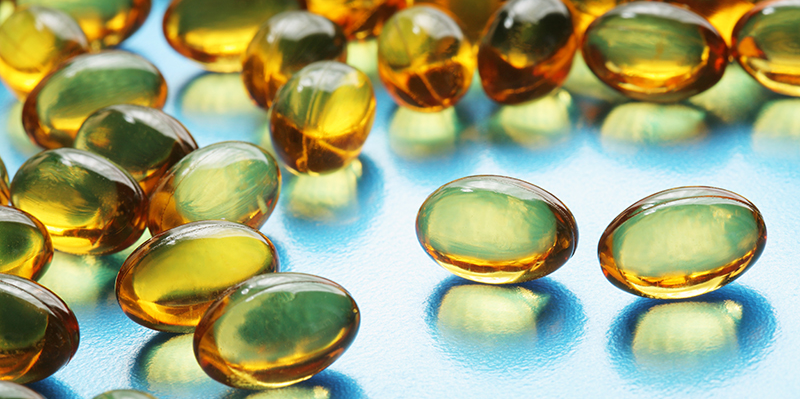Increasing vitamin D supplementation

Elderly women should take in more vitamin D than previously recommended during the winter months. This is the finding of a new study just released by a team of researchers led by ETH Professor Michael B. Zimmermann.
Osteoporosis is one of the chief reasons why the elderly often suffer broken bones from relatively minor injuries. Postmenopausal women in particular experience a relatively rapid loss in bone mass due to a reduced concentration of oestrogen, which is responsible for strong bone growth during youth. Maintaining bone mass requires physical exercise and vitamin D, which is mainly produced in the skin with the help of UVB radiation. This is why, especially in the wintertime, many elderly women are prescribed a vitamin D supplement by their doctor to maintain bone mass.
When it comes to determining the correct dosage, however, this supplement is the topic of more expert debate than any other nutrient. One camp believes that sunlight alone is enough to provide the body with sufficient vitamin D, and therefore only small quantities of supplements are necessary. The other asserts that it takes high doses of vitamin D supplements to prevent or slow down bone degeneration in elderly women.
How much is enough?
A group of researchers at ETH Zurich and the Universities of Zurich and Bern led by ETH Professor for Human Nutrition Michael B. Zimmermann took a closer look at this question. The team of scientists wanted to find out how much vitamin D there needs to be in the bloodstream to maintain bone strength.
Surprisingly, the results of their study have come out clearly in favour of higher supplement doses. Particularly in the wintertime, much higher dosages of vitamin D are necessary than previously assumed in order to maintain bone health. In the study, the researchers come to the conclusion that a vitamin D concentration of 40 micrograms per litre of serum in the bloodstream is ideal for slowing or preventing bone degeneration in postmenopausal women.
During the study, test participants were first given a single dose of calcium-41. This disperses like normal calcium throughout the body and into the bones and, given enough time, will mark the entire skeletal system evenly. "It's after about six months that things get interesting, because from that point on we can trace the absorption and depletion of calcium in the bones," says Zimmermann. However, highly sensitive measuring equipment is required to detect the minute quantities of calcium-41 present.
Researchers took urine samples from test participants at regular intervals and then used highly sensitive accelerator mass spectrometry equipment - which is found at ETH Zurich's Laboratory for Ion Beam Physics and just a handful of other facilities worldwide - to measure the quantities of calcium-41 and calcium-40 and determine the ratio between them. To put it simply, a very low ratio means more calcium is being added to the bones than released; a high one means the bones are releasing more calcium than they are taking up.
Increased calcium absorption
Over a period of nine months beginning half a year after the calcium-41 marking of their bones, the women were given daily vitamin D supplements. The first dose was administered in early spring, when the vitamin D concentration in the blood is expected to be at its lowest, and the dosage was increased in step increments every three months. In addition, the scientists led by Zimmermann modelled the paths the calcium took through the various segments of the body in order to calculate an ideal vitamin D quantity.
At the beginning of the experiment, participants showed a concentration of 16 micrograms per litre of serum, which is to say they already had a deficiency. By the end of study, the average vitamin D concentration in their serum had risen to over 46 micrograms per litre thanks to the vitamin D supplementation - and to the sunshine, which increased over the course of the study to promote the body's natural vitamin D production.
At the same time, the researchers noted that the ratio of calcium-41 to calcium-40 decreased abruptly following the start of the supplementation regimen - a sure sign that bone degeneration had been reduced.
Increasing vitamin D supplementation
"Experts are divided as to the ideal daily dose of vitamin D for maintaining bone mass," says Zimmermann. This study has provided important new insights with respect to this topic.
For healthy postmenopausal women with sufficient calcium absorption and physical activity, a serum concentration of around 40 micrograms of vitamin D per litre of serum has the optimum effect on bone calcium absorption. "That the figure was so high was surprising," says Zimmermann, "as previously I had tended to believe that a low dose of vitamin D was sufficient."
In principle the body creates vitamin D in the form of cholecalciferol within the skin itself. But for this to occur, the body needs to be exposed to a sufficient amount of sunlight. In the winter months the sun is too low in the sky beyond the 40th latitude, which causes the body's natural vitamin D production to be too low. Only a few food types, such as cod liver oil or saltwater fish, contain larger quantities of natural vitamin D; smaller quantities can be found in eggs, meats, milk and butter. Vegetables, nuts and fruits contain only very little if any vitamin D. Not only is this vital nutrient necessary for optimum uptake of calcium in the bones, it also controls countless important cellular and immune processes. One example of severe vitamin D deficiency is rickets, which causes skeletal deformation.
More information: Schild A, Herter-Aeberli I, Fattinger K, Anderegg S, Schulze-König T, Vockenhuber C, Synal H-A, Bischoff-Ferrari H, Weber P, von Eckardstein A, Zimmermann MB: Oral Vitamin D Supplements Increase Serum 25-Hydroxyvitamin D in Postmenopausal Women and Reduce Bone Calcium Flux Measured by 41Ca Skeletal Labeling. Journal of Nutrition 2015, 145: 2333-2340, DOI: 10.3945/jn.115.215004

















